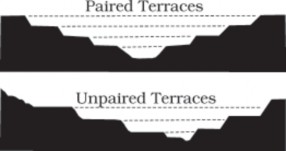7.2.2. River Terrace
A river terrace is remnant of a former floodplain which has been left at a higher level after rejuvenation of the river. Where a river renews its down cutting, it sinks its new channel into the former flood plain leaving the old floodplain above the level of the present river. There terraces are cut back as the new valley is widened by lateral erosion. If renewed rejuvenation takes place, the process is repeated and a new pair of terraces is formed beneath the original ones. The River Thames has created terraces in its lower course by several stages of rejuvenation. Terraces provide useful shelter from floods in a lower-course river valley, and natural route ways for roads and railways. The built-up areas of Oxford and London are mainly located along the terraces of the River Thames.
When a terrace is present only on one side of the stream and with none on the other side or one at quite a different elevation on the other side, the terraces are called non-paired terraces. Unpaired terraces are typical in areas of slow uplift of land or where the water column changes are not uniform along both the banks.

